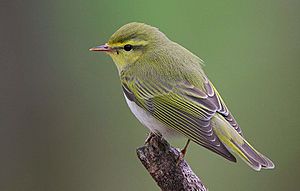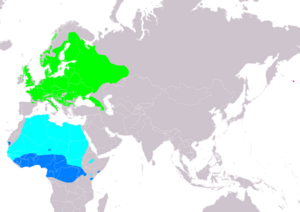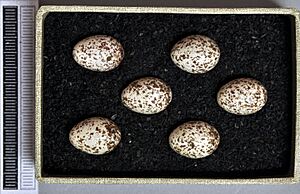Wood warbler facts for kids
Quick facts for kids Wood warbler |
|
|---|---|
 |
|
| In Inversnaid, Scotland | |
| Conservation status | |
| Scientific classification | |
| Genus: |
Phylloscopus
|
| Species: |
sibilatrix
|
 |
|
| Range of P. sibilatrix Breeding Passage Non-breeding Vagrant (seasonality uncertain) | |
The wood warbler (Phylloscopus sibilatrix) is a small, common bird found across Europe and parts of Asia. It's a type of leaf warbler, known for its green and yellow feathers. These birds are migratory, which means they travel long distances. Every year, the entire population flies from their breeding grounds in Europe and Asia to spend the winter in warm, tropical Africa.
Contents
What's in a Name?
The scientific name for the wood warbler is Phylloscopus sibilatrix. Let's break down what that means!
- The first part, Phylloscopus, comes from two Ancient Greek words: phullon, meaning "leaf," and skopos, meaning "seeker" or "watcher." So, it's like a "leaf-seeker."
- The second part, sibilatrix, is a Latin word that means "she who whistles." This name probably comes from the bird's unique song.
A long time ago, at the end of the 1800s, some people also called this bird the "wood-wren."
Where Do Wood Warblers Live?
Wood warblers love to live in open, but shady, grown-up forests. They especially like woodlands with beech and sessile oak trees. They need some sparse plants on the ground to build their nests.
Nesting and Eggs
The wood warbler builds a dome-shaped nest very close to the ground, often hidden in low bushes. In May, the female bird lays about six or seven eggs. Sometimes, they might even have a second group of chicks later in the year!
Like many other Old World warblers, these small birds eat mostly insects.
What Does a Wood Warbler Look Like?
The wood warbler is a small bird, about 11 to 12.5 centimeters (around 4.3 to 4.9 inches) long. It looks like a typical leaf warbler. It has green feathers on its back and white feathers on its belly. Its chest is a bright lemon-yellow color.
You can tell it apart from similar birds, like the chiffchaff or the willow warbler, by a few key features:
- It has a bright yellow stripe above its eye, called a supercilium.
- Its throat and the top part of its chest are also yellow.
- The edges of its wing feathers (called tertials) are pale.
- Its wingtips extend further out.
- Its tail is shorter but wider.
Where Are They Found?
Wood warblers visit the United Kingdom during the summer, usually from April until August. Sadly, their numbers have been going down there in recent years. They are quite rare in Ireland, but there is a small group that breeds in County Wicklow.
The types of forests they live in are very important for wood warblers. Things like how steep the land is, how much forest cover there is, the number of broad-leaf trees, and the height of the tree canopy all affect where these birds choose to live. Because their numbers are declining, it's important to protect and maintain the kind of forests they prefer.
Even in their winter homes, like Ghana in Africa, they prefer forests. However, these forest habitats are also shrinking. While wood warblers can sometimes adapt to areas with fewer trees, losing too many trees will likely harm them in the future.
How Do Wood Warblers Sing?
The wood warbler has two main types of songs, and they often sing them one after the other.
- One song is a high-pitched, clear, metallic trill. It gets faster and faster and lasts for about 2 to 3 seconds.
- The other song is a series of 3 to 5 lower-pitched, piping notes that go down in sound, like piüü-piüü-piüü.
When they want to call to each other, they make a soft piping sound. It's similar to the second song type, but it's shorter and just one note, like piü.
Images for kids






